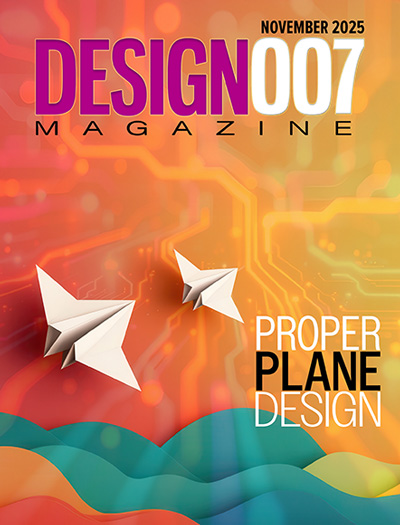-

- News
- Books
Featured Books
- design007 Magazine
Latest Issues
Current Issue
Designing Proper Planes
Without planes, designers would have to create thousands of traces to accomplish the same objectives. Power planes provide low impedance and stable power, and ground planes stabilize reference voltage, improve thermal performance, and help preclude EMI issues.

Power Integrity
Current power demands are increasing, especially with AI, 5G, and EV chips. This month, our experts share “watt’s up” with power integrity, from planning and layout through measurement and manufacturing.

Signal Integrity
If you don’t have signal integrity problems now, you will eventually. This month, our expert contributors share a variety of SI techniques that can help designers avoid ground bounce, crosstalk, parasitic issues, and much more.
- Articles
- Columns
- Links
- Media kit
||| MENU - design007 Magazine
EMA Announces Ultra Librarian for OrCAD
August 23, 2016 | EMA Design AutomationEstimated reading time: 2 minutes
EMA Design Automation, a full-service provider and innovator of EDA solutions, has just announced Ultra Librarian for OrCAD providing symbols and footprints for over 7 million parts.
“Engineers lose far too much time creating or searching for symbols and footprints,” said Manny Marcano, president of EMA Design Automation. “There are band-aid solutions floating around that are either woefully lacking in parts or they only provide one piece to the puzzle—like a footprint, but not a symbol. The vast majority of our OrCAD community starts a design with a schematic, so these alternatives were simply not acceptable.”
EMA’s considerable experience with how an OrCAD user works throughout the day has shown that engineers often spend hours and days building schematic symbols and PCB footprints. This effort is often not taken into consideration while scoping project timelines, causing delays and missed milestones. Seeking a solution, EMA created Ultra Librarian for OrCAD as a software plugin making it incredibly easy for the OrCAD user to instantiate a new part on their design. The plugin provides access to a vast cloud-based library of pre-built and validated EDA components, giving engineers confidence that their symbols and footprints are accurate and correctly linked. Having a tight integration within OrCAD Capture eliminates the need to leave the design environment to find or create the part components required to complete the design. With Ultra Librarian for OrCAD, engineers can focus on their design work rather than manually creating each entity that makes up an EDA part.
EMA is currently enlisting select customers to join the early adopter program. These users will be able to try out the solution and provide feedback on functionality, ease of use, speed, and additional capabilities.
“Symbol and footprint generation has always been a void in the market as EDA vendors have focused on features rather than content,” said Marcano. “Ultra Librarian for OrCAD fills that gap for our OrCAD customers, providing them with access to the ‘Gold Standard’ for EDA libraries.”
For anyone interested in participating in the early adopter program, go to go.ema-eda.com/UltraLibrarian. To learn more about EMA go to ema-eda.com or call 585.334.6001.
About EMA Design Automation, Inc.
EMA Design Automation is a trailblazer in product development solutions offering a complete range of EDA tools, PLM integrations, services, training, and technical support. EMA is a Cadence Channel Partner serving all of North America. EMA develops Ultra Librarian, TimingDesigner, CircuitSpace, CIP, EDABuilder, and a host of custom solutions to enhance the OrCAD products, and all are distributed through a worldwide network of value added resellers. EMA is a privately held corporation headquartered in Rochester, New York. Visit EMA at ema-eda.com for more information
Testimonial
"Our marketing partnership with I-Connect007 is already delivering. Just a day after our press release went live, we received a direct inquiry about our updated products!"
Rachael Temple - AlltematedSuggested Items
Zuken Opens Call for Papers for ZIW Americas 2026
11/13/2025 | ZukenZuken USA, Inc. opens the Zuken Innovation World (ZIW) Americas 2026 Call for Papers to help engineers, managers, and leaders showcase proven results and advance industry best practices. ZIW is Zuken USA’s semi-annual Digital Engineering conference on electrical and electronic design for engineers, managers, and industry leaders. It focuses on current practices and emerging trends with practical takeaways.
Innatera Signs Joya as ODM Customer, Bringing Neuromorphic Edge AI into Everyday Connected Products
11/13/2025 | PRNewswireInnatera, the leader in brain-like neuromorphic computing for ultra-low-power intelligence at the sensor edge, today announced that Xiamen Joyatech Co., Ltd. has become its first Original Design Manufacturer (ODM) customer.
Advanced Electronics Packaging Digest: Third Issue Arrives November 17
11/12/2025 | I-Connect007The third issue of Advanced Electronics Packaging Digest launches Monday, November 17. This issue continues AEPD’s mission to deliver forward-looking analysis and insider perspectives on the technologies reshaping advanced electronics packaging. Among the highlights is a review of IMPACT 2025, where discussions on component-to-system-level integration took center stage as experts explored the challenges and breakthroughs driving advanced packaging technologies.
Electronic Design Automation (EDA) Market Size to Reach $811.1 Million by 2030
11/12/2025 | PRNewswireThe Global Electronic Design Automation (EDA) Market was estimated to be worth USD 541 Million in 2023 and is forecast to a readjusted size of USD 811.1 Million by 2030 with a CAGR of 6.4% during the forecast period 2024-2030.
The Technical Backbone of an EMS Company: A CEO’s Perspective
11/13/2025 | Jay Rupani, Precision PCBAs the CEO of an EMS company, I often say that our business runs on precision, innovation, and trust. Behind every finished product—whether it’s a medical device, an automotive control module, or a consumer gadget—lies a sophisticated technical ecosystem that makes it all possible. From design support and process engineering to automation, data analytics, and supply chain integration, the technical side of EMS is where our value truly shines.


